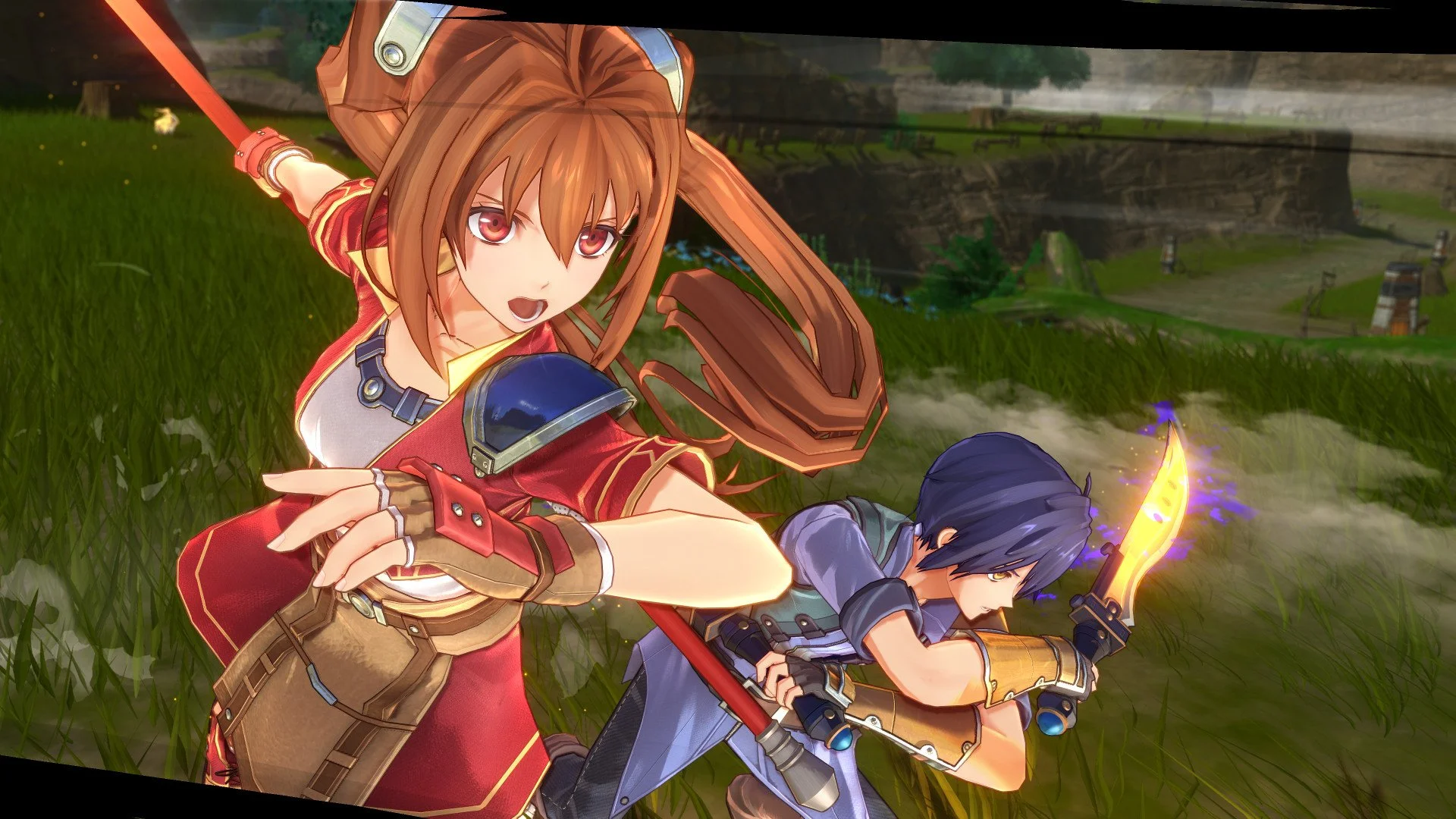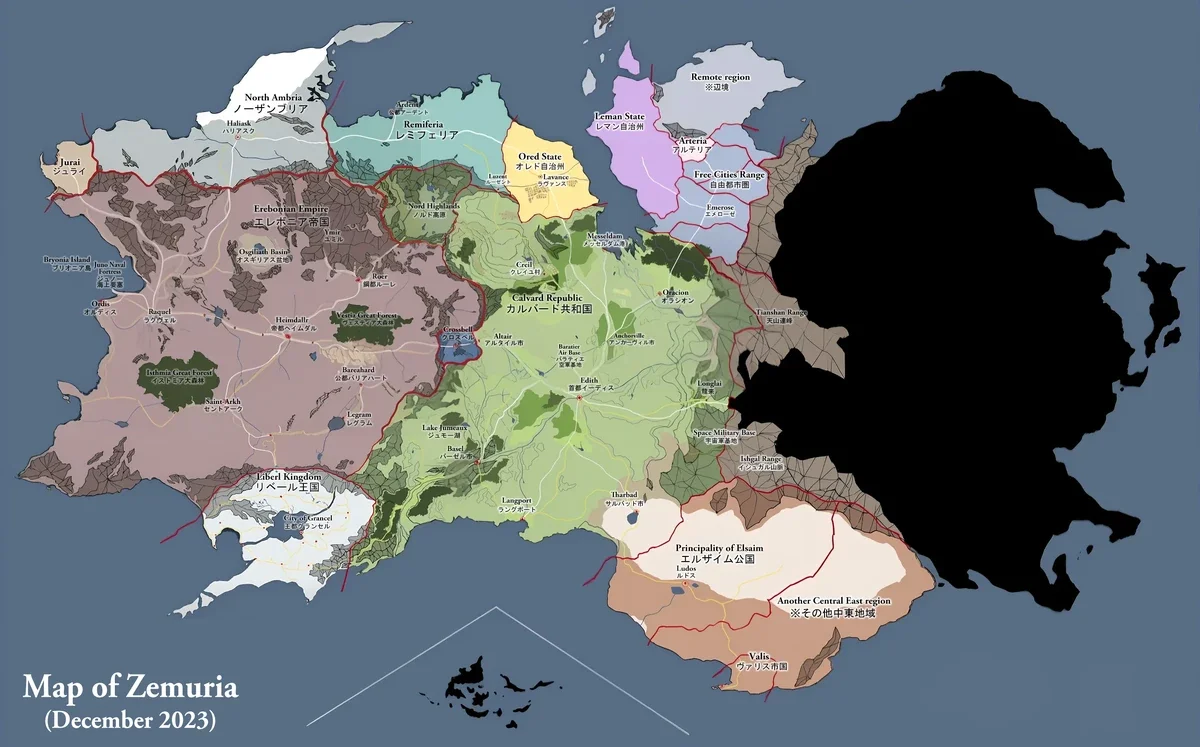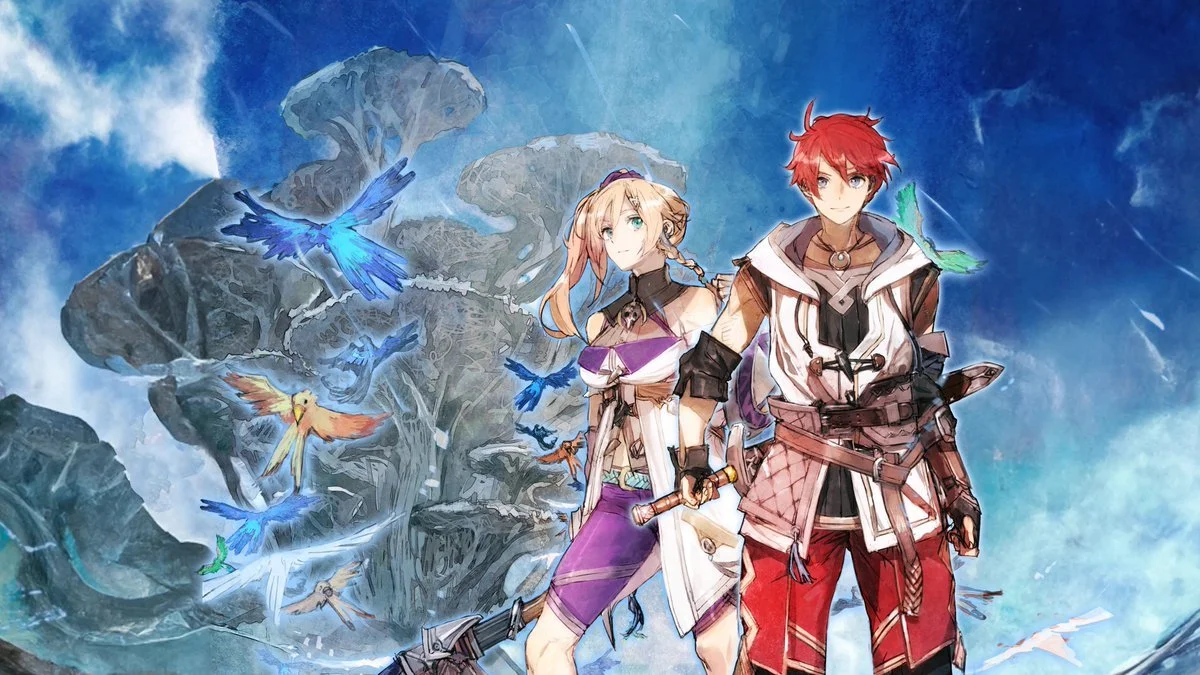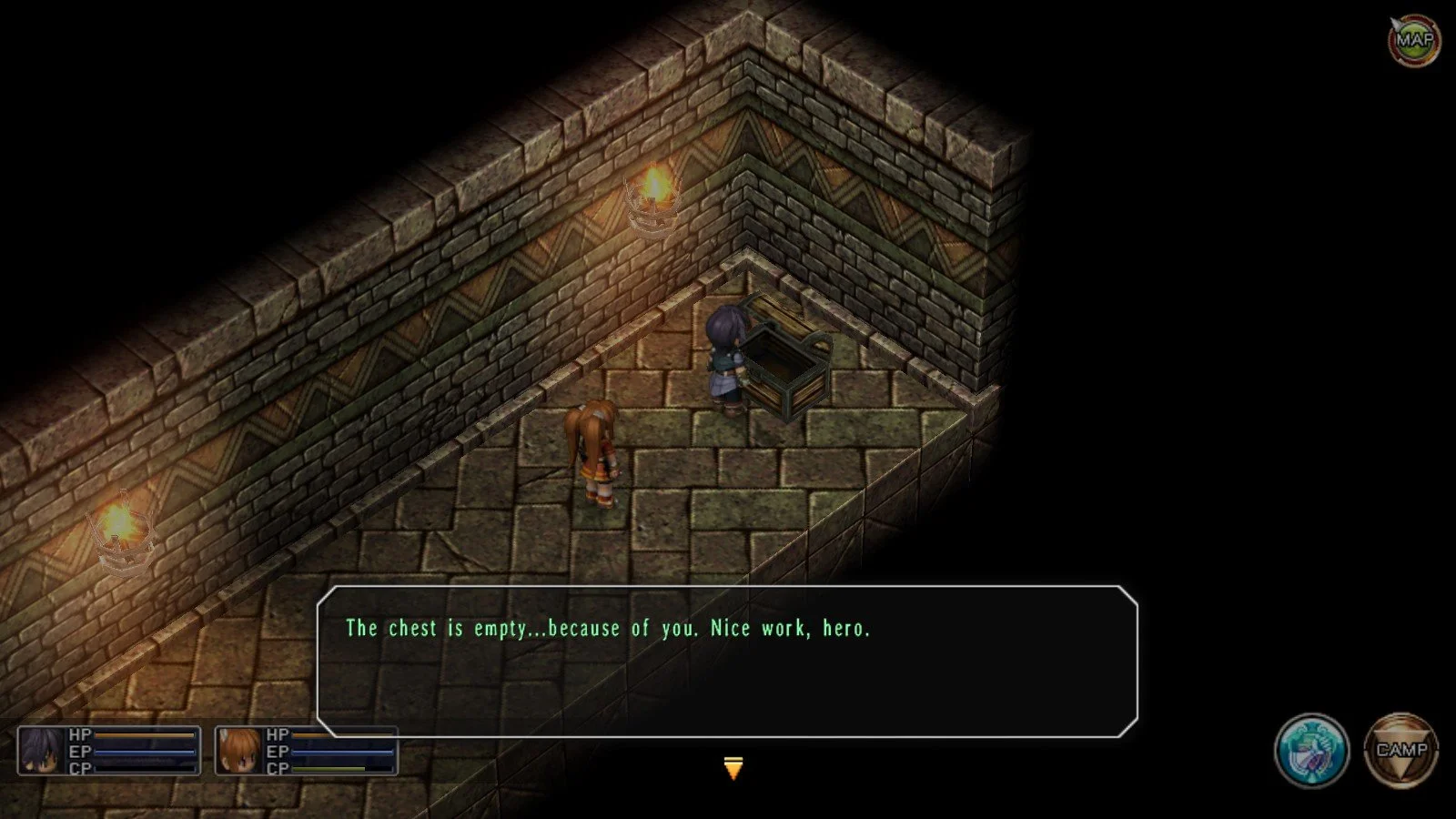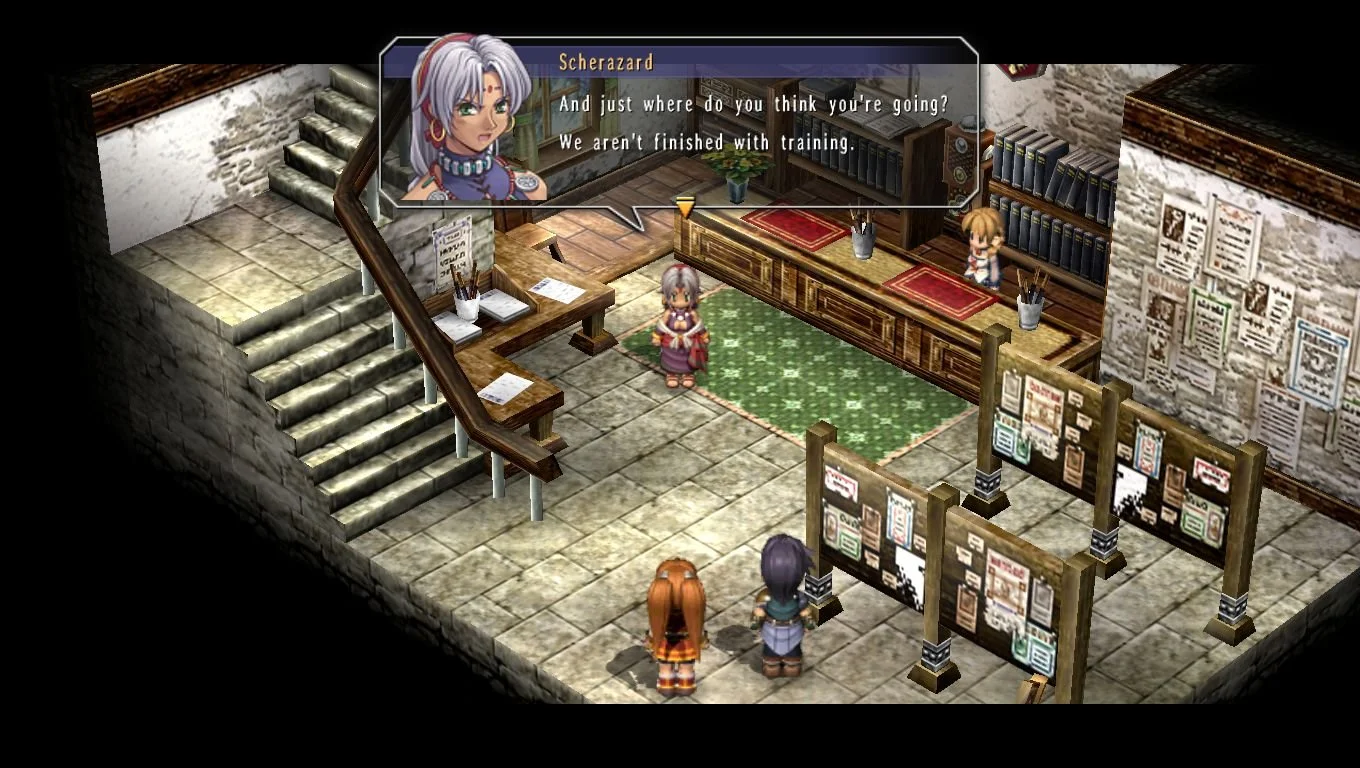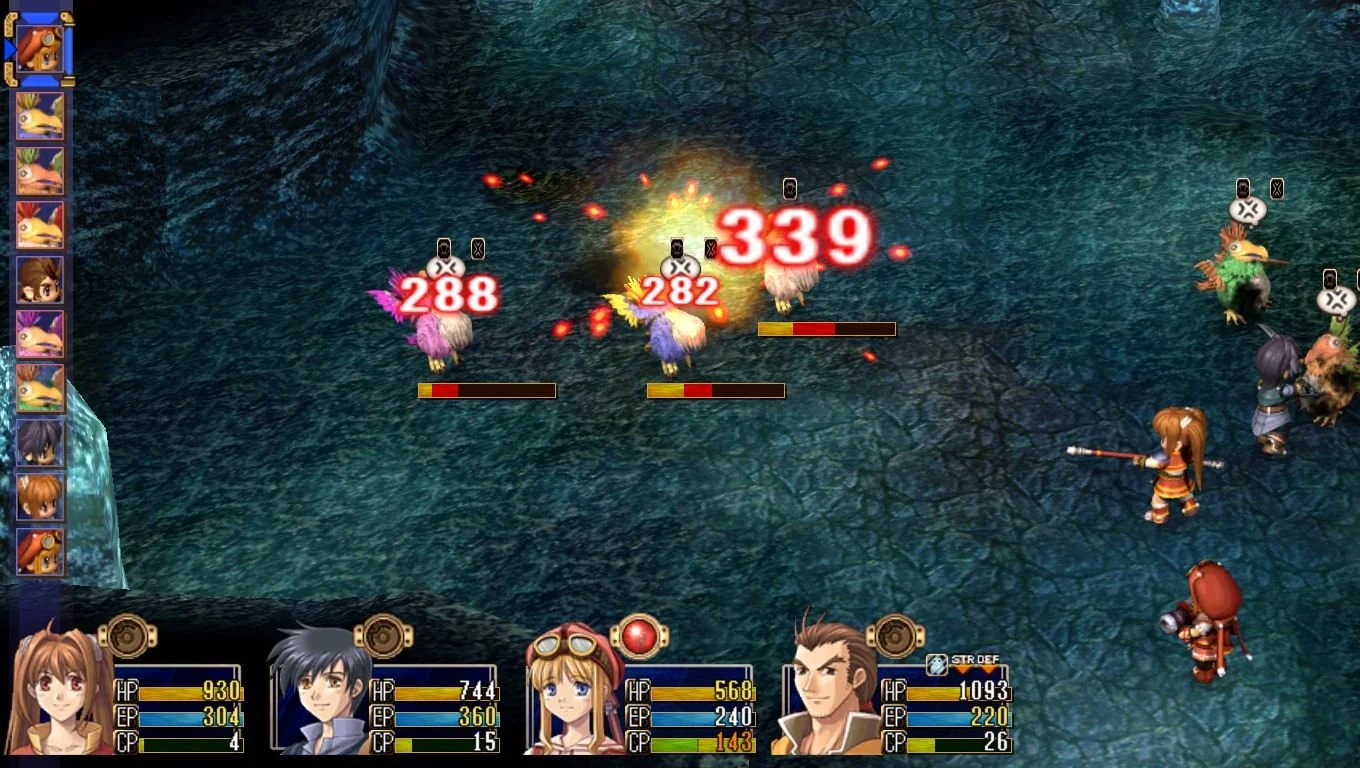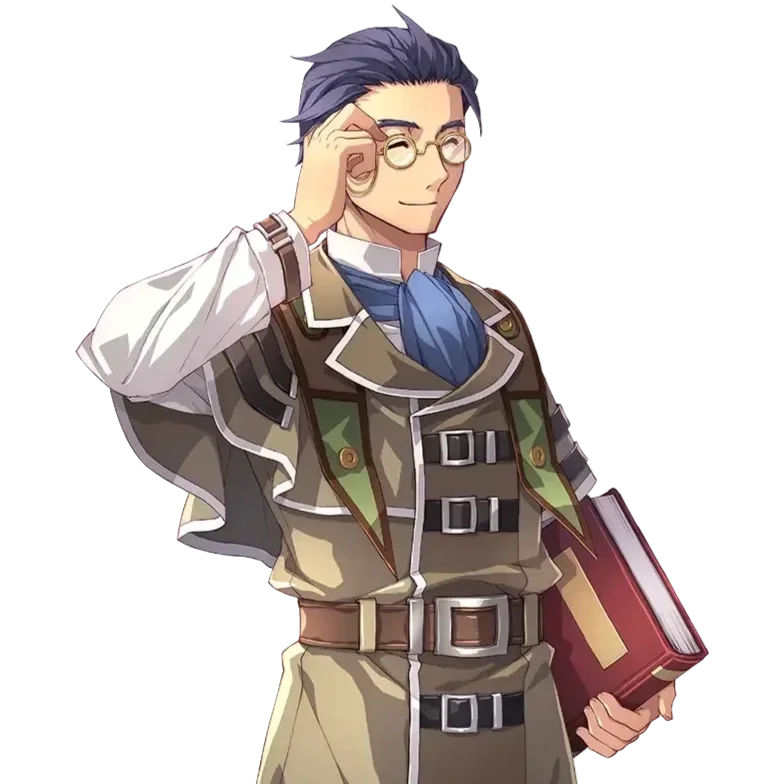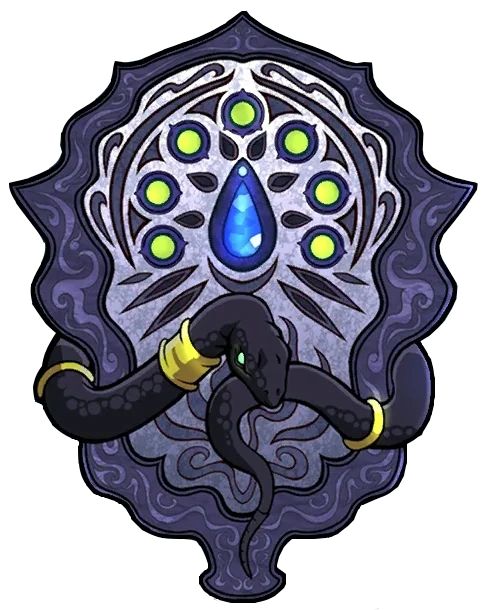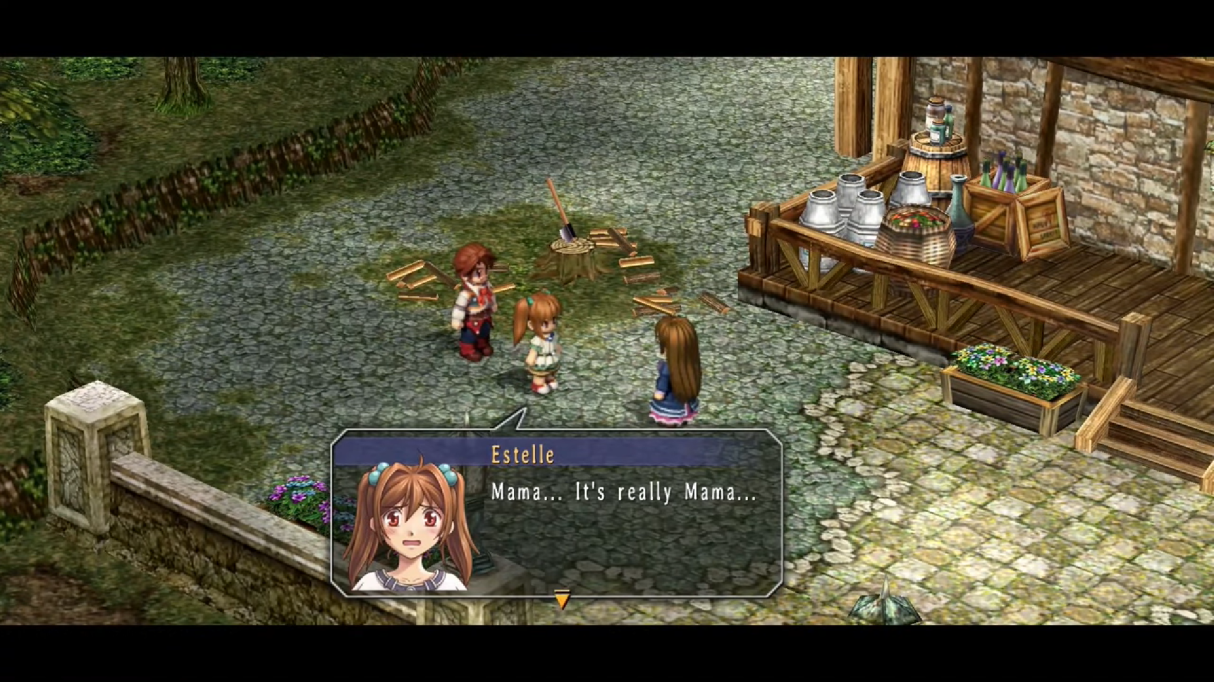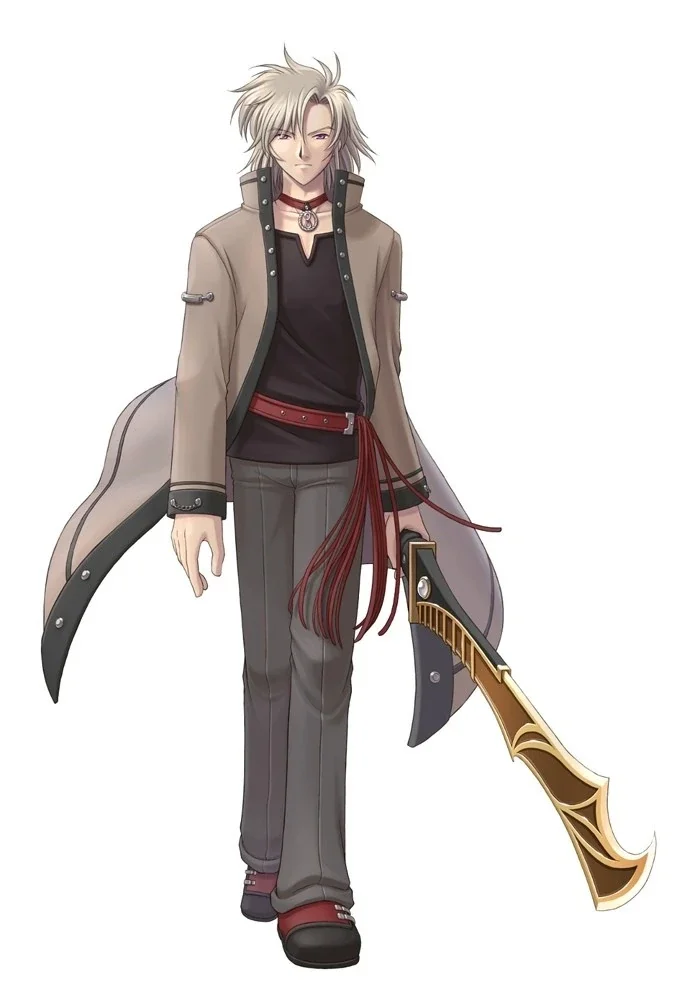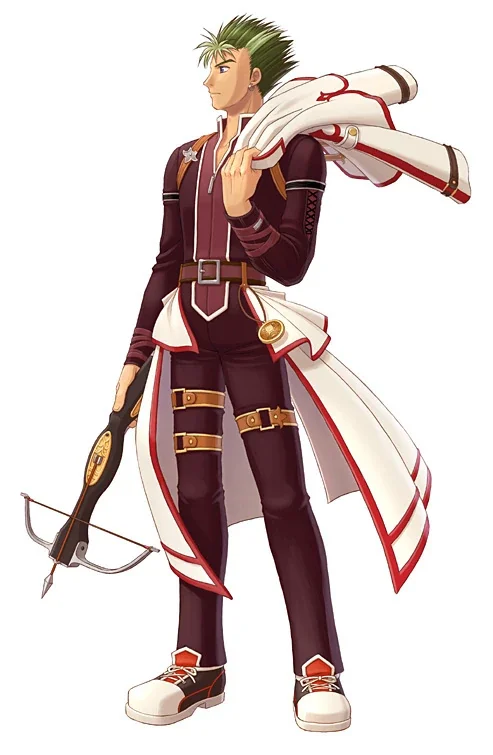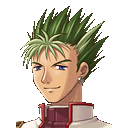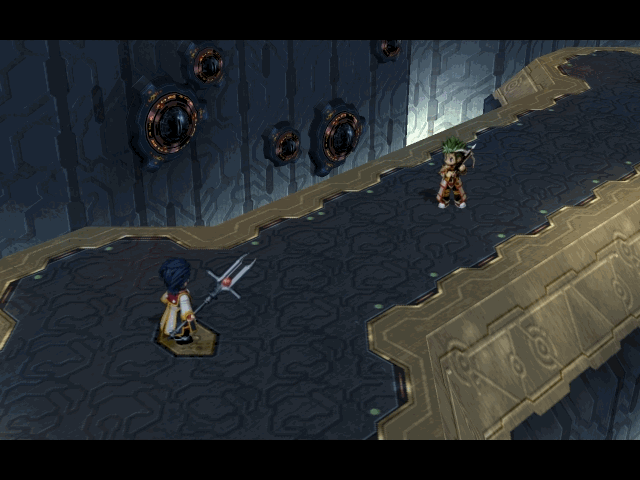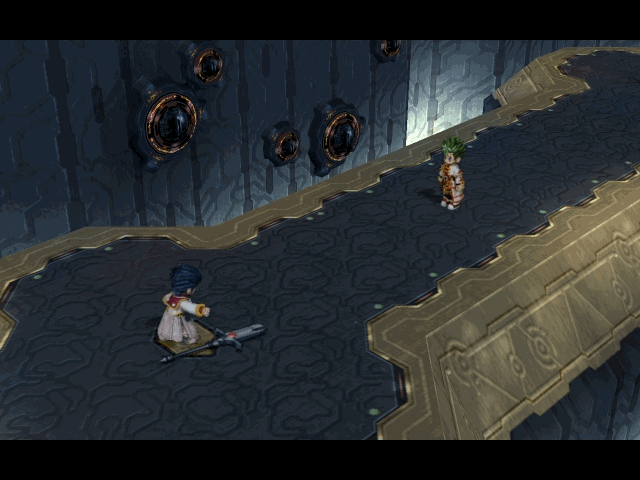Introduction
I wanted to start this off with some kinda poignant statement. Something about the nature of epic fiction, or the importance of art made by people or companies that aren’t in the big leagues of media production. Something about the importance of not just world-building, but world-designing, and the ways great stories—interactive media especially—utilize classic, familiar tropes in unique and unexpected ways. I just couldn’t put the words together to sum up everything I wanted to say (I say, thousands of words into this script).
So instead, I’ll start off with this: Many game series have come and gone in the last twenty years. Some were already long-runners, some were newfound hits that managed to withstand the turbulent nature of the games industry, and some rarely made it past the first month of sales. To make it as far as the big 2-0 is impressive enough. To do so while telling a story that encompasses hundreds of hours of gameplay, with a character roster that stays remarkably consistent between titles in a chronological narrative spanning years and years in-universe, with a setting that’s so alive and rich with personality and possibility, and with a superb level of quality that even its worst-received outings have something that makes you go “Man, I wish more games were like this…”
That’s gotta count for something, right?
Image courtesy of Gematsu.
—
The Trails series (or Kiseki, its Japanese title, if you want to avoid confusion with a certain other series with a similar name and much more brand recognition) is an RPG series following the adventures of multiple casts of characters on the continent of Zemuria, a land where monsters and mysticism live side by side with technology and rampant industrialization. Sure, it took an unexplained calamity hundreds of years ago for them to get to this point, but they’re past that now. By the grace of the sky goddess Aidios, they’ve seen advancement after advancement. Something like a horrific, world-ending calamity definitely won’t be relevant again.
Yeah, definitely.
Hey, why do so many of the Japanese titles say things like ‘The End’ and ‘Farewell’ and oh dear—
Image courtesy of the Kiseki wiki.
For many, many, many reasons, life isn’t exactly peaceful in Zemuria, with various countries vying for supremacy, survival, and relevancy on the world stage. Within these countries are numerous organizations with their own mini-power struggles, with the civilians caught in the crossfire either blissfully unaware or extremely jaded by these clashes. Some, like the do-gooder league known as the Bracers, the ever-present Septian Church and its pious believers, and the malicious mafia known as Revache, have already ingrained themselves into society for better or for worse—but at least the people at least know about those ones. Put a pin in that for now.
Point is, not all is well in the states of Zemuria, but a few scattered heroes across its lands— heroes who don’t even know yet the legends they will leave in their wake—are about to change that.
—
The Trails series is split up into a few sub-games: Trails in the Sky, following a pair of youngins seeking their missing father in the Liberl region; the Crossbell Arc consisting of Trails from Zero and Trails to Azure, focusing on the efforts of the wannabe-detective Lloyd Bannings and his Special Support Section as they try to clean up the city-state of Crossbell; Trails of Cold Steel, which brings players to a military academy in the Erebonian Empire and into the shoes of student Rean Schwarzer and his oddball classmates; and the most recent sub-series Trails through Daybreak, following the mercenary-ish-for-hire Van Arkride and his Arkride Solutions detective agency in the Republic of Calvard.
In-between the first two Sky games and the Crossbell arc is Trails in the Sky: The 3rd, and in-between Cold Steel and Daybreak is Trails into Reverie, both acting as sort of bridge games closing the loops on the prior titles and opening up new plot points for future ones. The most recent of these bridge games is Kai no Kiseki: Farewell, o Zemuria, which dropped in September 2024 in Japan and will launch as Trails across the Horizon in January 2026 in the west (and is supposedly like… the 70% mark of the series? I don’t trust it, personally; if I’ve learned anything as a One Piece fan, the story will end when the creators damn well please and no sooner).
We also have mixed into the fray the spinoff title The Legend of Nayuta: Boundless Trails. While it’s not directly involved in the series (Y E T, give it a few more games and they might change their minds), it carries the Trails storytelling tradition and aesthetic style in an original setting with action RPG mechanics.
That massive list might seem daunting, but for the most part—and I’m going to piss off a lot of people with this— you can jump in at the start of most of these sub-series and still get a lot out of it. Pick whichever story pitch and characters that catch your fancy and go from there.
To be entirely clear, you’ll want to jump in at the start of a sub-series. That means Trails in the Sky, Trails from Zero, Trails of Cold Steel, or Trails through Daybreak. Some of these games will contain much more lore connections with others as they go on, but once you’ve beaten at least one of them, you’ll either know you’re not gonna continue, or you’re going to go seek out the other games anyway to figure out who the hell this one lady is and why she seems to know that guy, and what the deal is with this one book, and what the actual Hell is this cascade of proper nouns supposed to mean—
You get the idea.
For context, I entered with Trails in the Sky (thank you, impulsive Steam sale purchases and insistent friends), and I mostly followed English chronological release order— there was a period of time where the Crossbell games were Japanese only, and I’d already hit credits on Trails of Cold Steel III by the time the localizations were announced, so I ended up going back to treat the Crossbell games as prequels. While I feel the way to get the most out of the series is to play in order, not everyone is going to be immediately sold on the older titles—maybe you’re more into the school life style you get from something like Persona and Cold Steel catches your eye, or maybe you’re looking at a Daybreak trailer wanting to play as the cool dude with the biker jacket, or maybe the old school pixel art of the Sky and Crossbell games doesn’t immediately appeal to you, and that’s fine. Despite what anyone else may say, that’s fine.
Just… don’t start with the second game in the sub-series, or any of the bridge games if you can help it. While Trails of Cold Steel III is a debatable case as it essentially acts as a soft reset of the character focuses and dynamics put in place by Trails of Cold Steel I, it also brings in characters from across all the series to culminate some of their storylines. It’s playable even then— I did that, after all— but you’ll likely still find yourself wondering why the game lingers so long on certain moments. You’ll get that here and there with any game after Sky, but you’ll get it in triplicate with ToCS III, so buyer beware.
One last note, added in very, very late because this retrospective was originally supposed to drop in 2024 (good going, me), a 3D remake of Trails in the Sky was announced by Falcom for a worldwide release in September 2025, titled Trails in the Sky 1st Chapter. While I would like to say it’s a great jumping on point for new fans (and it probably is, all the same), I’m withholding judgment until the game actually drops and we see what Falcom decided to do to their flagship title. Looks great though, so hopes are high.
—
Full disclosure, I’m not exactly unbiased about my love for the Trails series for more reasons than one. I’ve made lifelong friends thanks to these games, I’ve written a whole damn Trails fansite, which is what a decent chunk of this will be based off of, and, without getting too into detail for privacy reasons, I have worked with one of the companies involved in the series in a non-game-dev, non-localization capacity. I want it to be clear from the get-go here: this is not some corporate shill telling you to buy the latest hyper turbo mega collector’s edition of the game, and this is entirely unsponsored by any of the companies involved with the games. I’m just… these games make me feel a certain way, y’know? Like…
Yeah, like that.
So, as a way to share my love for this franchise to any interested parties, and to provide a refresher for those who already know and love the games, I’m here to give you a brief breakdown of what makes this series special, despite having not finished the whole series as of yet.
“If you haven’t finished it,” you ask, “why in the world are you talking about it?”
I may not have finished the series, but I think with hundreds of hours invested across many games and even more years, I at least have the leeway to say something.
Look, I’m sorry, I just wanted to play Crossbell before starting Trails of Cold Steel IV and I only beat Zero most recently, and then I gotta get through Azure and go back to Cold Steel and then play Reverie and Daybreak 1 and 2, and why is Horizon already almost here, and these are all sixty-plus hour games and I’M SORRY I JUST WANTED TO TAKE A BREAK TO PLAY THE P5 TACTICS GAME AND UNICORN OVERLORD JUST CAME OUT AT THE TIME I STARTED THIS SCRIPT AND THEN METAPHOR: REFANTAZIO CAME OUT RIGHT WHEN I FINALLY GOT TIME TO PLAY ANYTHING AT ALL AND THEN I FELL BACK INTO THE P5 ROYAL RABBIT HOLE AND HOW IS IT ALREADY ALMOST HALFWAY THROUGH 2025 I STARTED WRITING THIS LAST JUNE WHAT IS W R O N G WITH ME—
Anyway, where my knowledge lacks, I’ll make it clear, and I’ll probably make a supplemental review covering any topics I missed.
(Or, reviews, plural, knowing my luck.
Hooboy.)
So, with that disclaimer out of the way, let’s get right into…
…a history lesson!
I promise I’ll be quick—
—
A BRIEF HISTORY OF NIHON FALCOM
Nihon Falcom Corporation was founded in 1981, and—after a brief stint making whatever the hell they felt like, from mahjong games to horror titles—quickly settled into the RPG genre with the Dragon Slayer, Xanadu, and Ys titles (among many, many more). Of these three, Dragon Slayer’s the most important to Trails’ history as it’s essentially the third generation of the franchise; Dragon Slayer made way for Dragon Slayer: The Legend of Heroes I and II (and its subsequent trilogy of titles, The White Witch/Prophecy of the Moonlight Witch, A Tear of Vermillion, and Cagesong of the Ocean/Song of the Ocean, known colloquially as the Garghav Trilogy, the name they eventually took for the gacha-centric mobile port), and The Legend of Heroes made way for The Legend of Heroes: Trails, which eventually became more popularly known by the latter part of the moniker.
While our focus is on Trails today, it’s well worth exploring the other titles produced by Falcom, given the sheer breadth of options. Xanadu and Ys both have carried onto the modern day, with titles such as Tokyo Xanadu (a more modern urban fantasy with DNA carried over from the original) and ten mainline games in the Ys series to date with plenty of gameplay innovations and unique stories to tell. Other Falcom titles like Zwei and Gurumin are readily available on PC platforms like Steam, and fan groups such as the Geofront have taken the lead on bringing over titles like Dinosaur, Ys vs. Trails in the Sky, and a retranslation of The White Witch, the first game in the Garghav trilogy. That last one is especially important, because that game caught the attention of Toshihiro Kondo, future president of Falcom. After making an online guide for the game, Kondo wound up working at Falcom in initially a web design role, but eventually wrote scenarios for different games at the company, and rose to the rank of director on multiple titles—including the first game we’ll be talking about today, after…
…HOW ARE WE FIVE PAGES INTO THIS DOC ALREADY—
—
THE LEGEND OF HEROES: TRAILS IN THE SKY
Directed by Toshihiro Kondo
Written by Hisayoshi Takeiri, Yoshihiro Konda, Shūji Nishitani, and Homare Karusawa
Music Composed by Falcom Sound Team jdk (Hayato Sonoda and Yukihiro Jindo)
Produced by Masayuki Katou
Localization by XSEED Games
(Credits courtesy of MobyGames, for the PSP Edition)
The Legend of Heroes: Trails in the Sky was originally released in 2004 for the PC and the PSP in 2006. To reiterate, the Trails series takes place on the continent of Zemuria, a land undergoing rapid change thanks to a recent technological revolution, powder-keg politics between neighboring countries, and all sorts of mysterious (and often sinister) forces lying just out of sight.
Trails in the Sky in particular follows Estelle Bright and her adopted brother Joshua, the newest members of the Kingdom of Liberl’s Bracer Guild (a collection of adventurers who offer aid and assistance to those who request it of them, primarily private citizens and folks who can’t get help from the military or the cops). When Cassius Bright, Estelle’s father and renowned Bracer, goes missing following the hijacking of an airliner, the two set out on a quest to find him. Their search leads them to different cities across the country, and they meet a wide cast of quirky characters as they seek out the truth of their father’s disappearance—and, in the process, begin to unravel a conspiracy that threatens the whole of Liberl…and possibly Zemuria itself.
Sky’s story and cast, for as much as I’ll praise it here, is the definition of bog-standard. At least, from the outset. Young do-gooders explore a vast land in search of truth, justice, and deal with one problem per episode—er, chapter. You’ve got the quirky bard, the punch-fighting guy, the definitely-not-a-princess, the rough-and-tumble dude with the heart of gold, the mystic mentor that reads tarot in the way that tarot isn’t actually supposed to be read, the Death card just means change, Scherazard—
And there’s a literal child!
With a gatling gun!
Who gave the child a gun, let alone one that spins?!
(Courtesy of Reddit user AlmightyXan)
Estelle and Joshua offer the most variety and depth in their characterization, with a close second coming to the wry Olivier and his over-the-top attitudes making way for a more clever soul underneath; some of the side characters and antagonists also have their moments, especially Josette of the sky pirate Capua Family. For the most part, though, the cast is a case of what-you-see-is-what-you-get. Especially Zin.
Pour one out for poor Zin, a guy who got lost on the way to becoming the generic Monk party member in a Final Fantasy game. It’s not like he’s entirely uninteresting, and from what I hear Daybreak does a lot to rehabilitate him, but here? He’s just happy to be invited.
At least his kit’s useful. Sometimes. Once or twice. When the stars align and the moon is in Capricorn.
Maybe First Chapter will do him better.
I hope.
I won’t get into everything here (in part because Sky is worth playing as fresh as possible, and in part because I will not survive if I try to do so), but the game is incredibly robust. There are plot twists, there are dramatic and intense moments, there are sweet scenes and the occasional tearjerker and the hype-as-hell moments, but at the end of the day, it’s standard… and I don’t think that’s bad. Sometimes, especially when you’re kicking off a series, you need something to lay the baseline. Sure, it’s fun to pick up a game and suddenly be thrown off your feet by every twist in the book, especially if you’re a power gamer and have seen a lot of the expected tropes dozens of times by now, but Trails in the Sky is… comfort food. It eases you into its world. “Here, have a cup of tea, you want some cake? Get cozy, you’ll have a nice time here.”
We’ll… get back to how long that lasts a little later.
I joke about the game feeling episodic, but it’s intentionally set up as such. Estelle and Joshua wind up in a new town, sign up to help the local Bracer guild, deal with a villain-of-the-week with their party-member-of-the-week, and set off in search of the next aristocrat and/or autocrat they need to punch in the face. What really makes the story stand out is the side content that you can engage with—many of the NPCs in the towns you visit have their own stories, their own lives, and their own side quests to go along with them. There’s mysterious towers dotting the lands that I definitely didn’t forget to go to the first time I played the game, there’s hidden adventures waiting for you to find them in the overworld, there’s books and other readables like newspapers that flesh out the setting and the events happening around the Brights’ travels. You also have a system in place called “Bracer Points,” which encourages you to respond to certain scenarios as a do-gooder should, showcasing Estelle’s growth into the role of the protective gauntlet that the Bracer Guild embodies. This… becomes relevant by the end of the game. Trust me, you want to do what you can if you want the most satisfying outcome possible.
And the treasure chests. Sweet Aidios, there are so many treasure chests. And, if you’re playing the localization by XSeed, each chest has a little bonus dialogue box that can be activated by clicking it again. They’re delightful, to say the least, and it’s a tradition carried through to Trails from Zero and Trails to Azure. The chests in the latter two were even partially fan-submitted. How do I know? One of mine got into Trails from Zero. Good luck finding it.
With the switch to the 3D-style Trails of Cold Steel, these messages were relegated to special chests only, and by the time Trails of Cold Steel III released they were gone completely. So… treasure them while you can.
I’m here all week.
Needless to say, there’s a lot to get out of the game if you just let yourself wander and explore—but the fact that anyone (certainly not me) can go through the main plot primarily and still get a pretty robust story out of it is a testament to the quality at the core of its storytelling.
Now, as I mentioned in the intro, the graphics may be something that can put people off if you’re more the type to go for the CG style of game visuals, or even HD-2D. The modern ports are crisp thanks to the work of the folks at XSeed, but it’s still a hard sell for many people. That said, the sprites are generally colorful, have a lot of vibrant animations, and are buoyed by an unbelievably expansive set of character portraits that come along with each dialogue box, really helping sell the emotions of each line and sequence. Plus, with the graphics as they are, they can run on practically any hardware, no matter how low-spec it may be.
I learned that the hard way when my external GPU died and I had to play Sky on integrated graphics.
Just sayin’, you could probably Doom it up and put Sky on a calculator if you wanted.
While Sky’s story and cast are on the average side, the gameplay offers a unique twist both for its time and in the grander scheme of RPG gameplay in general. Overworld traversal eschews random encounters for on-field enemies, and each location in the game can actually be explored in high detail. If you want to see what’s behind a tree or on the other side of a wall, you might find something unexpected that won’t try to bite your nose off; there’s also a few mini-games, such as fishing, that help vary up the regular gameplay loops. The available weapons and armor in the game are your standard RPG fare—swords, staves, whips, the occasional gun, etc.—and some of the best items can be found in treasure chests as opposed to store shelves. You’ll have a lot of room to outfit your characters as you see fit, but most fall cleanly into pretty familiar combat roles—which, speaking of…
Combat is where Sky really shines. While not as granular in its moment-to-moment action as something like the Bravely, SaGa, or Shin Megami Tensei series, it offers a wide variety of options for how you want to lay into your enemies. Combat is on a tiled field, where you can move your characters within a range allocated by their current movement stat. You can then choose from a number of options (basic attacks, items, etc.) when it’s your turn, signified by a bar on the side of the screen showing your current turn order—including the enemy’s own. While you can wallop whoever stands in your way with Estelle’s staff or fillet some foes with Joshua’s dual-blades, you can also use mystical Arts to perform elemental attacks on your foes. These are granted by electronic devices/magic rocks known as quartz—think Materia from Final Fantasy VII— that you place into orbments, machines that essentially act as a focus for said magic rocks. Some quartz allow for direct magic usage, such as fire and wind attacks, while others offer buff and debuff abilities. Others grant higher base stats like speed or movement, along with certain special abilities that can turn the tide of battle. Some quartz even offer benefits outside of battle, such as making sure all enemies miss you on the field, or revealing the location of treasure chests on the map.
On top of that, the game’s Craft system gives characters attacks unique to them alone, all with various utilities and uses. Joshua, for example, can use Flicker to cause an AT Delay on the opponent, kicking them down a few notches on the turn order. Estelle, meanwhile, has Hard Break, which allows her to prevent the enemy’s use of crafts or Arts. Super attacks known as S-Crafts can even interrupt enemy turns, allowing for snap decisions that can save you from an untimely demise— and whack the unfortunate souls in range straight into next week.
Then there’s the music. Oh, my god, the music. Falcom Sound Team jdk hits that fun, vibrant adventure feeling impeccably across the soundtrack. From the relaxing, small-town tunes to the jauntier combat ballads, to some more dangerous-sounding tracks as the villains’ machinations begin to expand, it’s clear that the team knew how to capture just the right vibes. While the above link has plenty of options, there are plenty of crisp, remastered editions of these tracks and more available over at the Falcom Music Channel… well, channel.
A few of my favorites are the opening tune (aka, the aptly named Trails in the Sky), the general combat theme (a jazzy, upbeat number called Sophisticated Fight), the main leitmotif of the game, (Hoshi no Arika/The Whereabouts of Light, heard across the game in various forms from hopeful to heartbreaking), and one more tune that I’ll save for a little later.
I also will say this here so I can cover my bases: Sky’s localization by XSEED Games is astounding. The work that went into making this game and its subsequent entries not just flow but thrive in English is astounding, with crisp and clever dialogue choices and endlessly quotable moments. For Trails in the Sky Second Chapter specifically, you can check out this incredibly fun episode of the YouTube video essay series What Happened? for more information.
As an aside, this isn’t to knock NISA for its work on the latter two Cold Steel titles, the Crossbell games, Reverie, Daybreak, or the upcoming Horizon; their efforts are impressive for how many other projects they have on their plate, and some moments are just as memorable as anything XSEED ever did—
—but they brought on board plenty of Sky's original localization folks during the localization of Reverie and Daybreak for a damned good reason, and in working with the base translation for the Crossbell games provided by The Geofront, they ensured all of the games in the series have a mostly consistent vocabulary and writing style across the board.
Like I mentioned before, I’m not here to tell you what happens in Trails in the Sky beat by beat (though I would never say no to any offer to do so outside of this article). However, I need to spoil the ending of the game in order to talk about the next one— and, for that matter, I’ll need to spoil two games’ endings as this article series goes along, since Sky FC and Sky SC have their own twists and turns that redefine what came before. As such, this is your big, honking spoiler warning: if any of this sounds interesting to you, and you want to go in as fresh as you possibly can outside of my cheeky little hints, stop reading for now and go play FC. If you’re already a fan and just looking for my two mira, or you don’t care about spoilers and wanna see where this goes—absolutely fair. Just giving a heads-up.
Off we go.
—
Over the course of Trails in the Sky, Estelle and Joshua end up meeting various oddballs and recurring weirdos who help them slowly unravel the ins and outs of the conspiracy threatening the country of Liberl. One of these weirdos (said entirely lovingly) is Professor Alba, a scholar studying the various ancient towers that were left behind following the disaster hundreds of years ago. If you play through the game, you’ll at least see him once in the main story; if you delve into the other towers, you’ll find him studying and getting himself into danger along the way.
Even if you only see him once like I initially did, he’s a very friendly, very open, and very danger-prone individual (not to mention a perennial broke humanities academic, which… yeah, mood). He makes you grin every time you see him, so when he appears once more after the final boss has been defeated, it’s great to see him again (especially as this is the portion of the game where it indulges in final vignettes for the characters you’ve met along the way). Estelle’s gone off for the moment to snag some victory ice cream, but Alba’s still happy to celebrate the success of the protagonists and enjoy the peace that’s returned to the city—
Yeah, Joshua ain’t buying it. Over the course of the game, there’s been hints that Joshua’s caught… something about this dude, something that just doesn’t seem right. Alba’s popped up one too many times in one too many convenient locations, and folks he’s been nearby happen to have very convenient bouts of megalomania and amnesia. Strange, that.
Joshua’s finally pinned Alba down as instrumental to whatever’s been going on, and he outright asks: “Was it you?”
Alba, to his credit, just flat-out goes: “Yeah. Also, here, have some trauma,” and snaps his fingers.
A bunch of proper nouns start getting tossed around— Snake Apostles, Anguis, Shining Ring, etc.— with the most important being Weissman the Faceless, the true identity of our beloved Professor. But the point isn’t who Alba is or what he’s scheming; that’s for later. The big reveal pertains to who Joshua is. You’ll remember that I mentioned earlier that Joshua was adopted into the Bright family, but what I didn’t mention—and what the game cleverly hides until this point, with a few teases sprinkled throughout— is that for the past half-decade, Joshua’s been acting as an unwitting spy for a mysterious secret society known as Ouroboros. He’s been feeding them information and details regarding the movements of the Bright family and (in particular) his father, famed Bracer and professional plot device Cassius Bright.
As an aside, I was playing this game live over Skype (God, I feel old) and my friends watched, muted, as I started yelling at the screen, “What is this Fullmetal Alchemist, Kingdom Hearts nonsense—!?” Again, said entirely lovingly, because inject this kind of nonsense right into my veins, please and thanks.
With a laugh, Weissman saunters off after adding on an existential crisis to Joshua’s slowly growing laundry list of traumas, shifting his focus onto Estelle for sequel shenanigans as she returns to an… oddly chill Joshua, who seems much more composed than he was a few seconds prior.
Well, it would make sense that Joshua wouldn’t just blurt out what happened immediately. After all, you have to leave a bit of mystery and intrigue heading into the next—
Yeah, Joshua goes into full “dark and edgy,” mid-2000s protagonist of an action RPG mode and decides he’s too awful as a person for Estelle to even consider being by her side, knocking out Estelle as he laments what could have been, confessing his love to her and swearing to hunt down Ouroboros himself, accompanied by an incredibly heartbreaking iteration of The Whereabouts of Light simply titled “Confession.”
Cue the credits.
If you could only hear the octaves my voice went up to as I screeched “THAT’S WHERE IT ENDS?!” over the sound of my friends’ laughter on our group Skype call.
This is what takes Trails in the Sky from a generic if well-designed RPG with a basic story and some generally interesting characters into a masterclass in video game storytelling. You’re used to how the ending starts; the heroes save the day, you get a feel for what the world is like, but you know, there might be some tension on the horizon. However, it doesn’t give you the kind of catharsis you’d expect, and instead tears your heart out as you realize that hey, maybe the characters being normal and sorta milquetoast means it’ll be unsettling when they don’t act like that. Joshua up to this point has been the dry, straight-laced type in opposition to Estelle’s bright and peppy personality, so to see him take that stoicness to its eerie, “this is how it has to be” extreme as he describes how much of a monster he sees himself as… that’s messed up, man. Even more messed up is Estelle’s reaction to all of this. They saved the day, they won, and—pushing aside the cultural differences in Japan regarding adopted siblings vs blood siblings, and with the caveat that the game treats Estelle and Joshua more as best friends who live in the same house than real siblings—she was going to get her crush actually answered, only to have her heart crushed instead, all to the Whereabouts of Light leitmotif in its saddest form. It’s a stunning cliffhanger, and it puts the entire game in a new light on second viewing.
There’s a reason for that. There’s a funny story about Trails in the Sky. You might hear it referred to as “FC,” or First Chapter, by a lot of people in the fandom. Why? Easy: It’s literally the first chapter. It’s not your usual “and the adventure continues” kind of ending, where the next big threat shows up later on after a peaceful however-long; the threats are still active and raring to go, we get a cliffhanger that leads into a far more Estelle-centric sequel, and we even get a trailer for the next game. Trails in the Sky was meant to be one full experience, but the company decided it was getting too unwieldy and would take far too long to release as one package. So, they shipped the first half of the game, took their time to touch up some things the team wanted to improve upon, and a couple years later, the world would receive…
-
THE LEGEND OF HEROES: TRAILS IN THE SKY SC (SECOND CHAPTER)
Directed by Toshihiro Kondo
Written by Hisayoshi Takeiri, Shinichiro Sakamoto, Yoshihiro Konda, Aichiro Miyata, Syunsei Shikata, and Masayasu Ogiso
Additional Writing by KureEiji, Umekichi, Kojika, Saki
Music Composed by Falcom Sound Team jdk (Hayato Sonoda, Takahiro Unisuga, Ryo Takeshita, Yukihiro Jindo)
Produced by Masayuki Katou
Localization by XSEED Games
(Credits courtesy of MobyGames, for the PSP Edition)
I mentioned earlier that there was one song I wanted to hold on discussing, and that song was Silver Will. Silver Will, in FC, was the boss theme of one Lt. Lorence, an enigmatic Jaeger who’d show up once in a while to mess with the party; Joshua, however, vaguely recognized him from somewhere—and it was confirmed in the ending that Lorence is actually a member of Ouroboros alongside Weissman. The reason this is important is because the theme song of The Legend of Heroes: Trails in the Sky Second Chapter is the same tune, but with lyrics and a full title: Silver Will, Golden Wings. It hints to Lt. Lorence—or rather, Ouroboros Enforcer #II, the Bladelord Loewe the Lionhearted (Falcom loves its epithets)—having an expanded role in this outing, but also to the main conceit of the narrative. It’s about two souls, their feelings shooting out like silver arrows as they seek each other out, wishing to meet each other again one day as they carve out trails in the sky (heh), which could—
NO, STOP, STOP THAT, WE’VE GOT AT LEAST SEVEN MORE GAMES AFTER THIS ONE—
—which could fit not just Estelle and Joshua’s star-crossed lovers situation, but the soon-to-be-unraveled familial relationship between Joshua and Loewe, or both Joshua and Loewe in relation to someone specific from their shared past.
(Check out this translation shared over at Endless History for some more fun insights!)
SC starts with a very different vibe than FC, with Estelle fleeing back to her and Joshua’s home to see if he’s waiting there for her. He isn’t. Estelle makes it her mission to track down Joshua and drag him kicking and screaming into the light … all while Joshua makes it his mission to track down Loewe and the other members of Ouroboros, with the help of a band of sky pirates from FC, the Capua Family, with the intent of defeating the Enforcers and their master, the Anguis Weissman, as penance for his dwelling in the dark. All the while, the snakes in the Society begin to enact their master plan, which will bring about either great change… or a second Collapse.
There’s a sense of melancholy throughout SC’s early chapters, where everything that was comfortable and familiar about the first game is thrown out the window as a larger tale unfolds. Characters grapple with the weight of their actions in the previous game, and slowly come to understand the gravity of the situation they’re dealing with as the threat to Liberl grows. The story continues to be episodic, with Estelle traveling across Liberl and teaming up with one or more of the party members from the last game each chapter, but it’s done so in a way that feels… scrambled. You visit the cities of Liberl in a different order than you did on your first go around, the characters you encountered later in the first game make early appearances, and you’re bouncing around the map trying to uncover what Ouroboros is up to—oh, yeah, right. We should talk about them for a sec.
Where FC’s villains were either pawns in a larger scheme or incidental to the particular locales you visited, SC has dedicated antagonists from the jump in the form of Ouroboros, Joshua’s former secret clubhouse. Various “Enforcers,” with a capital E, are experimenting with technology, modern and ancient alike, in order to bring about… something. The game cleverly leaves enough information for the discerning player to put the pieces together, but only outright reveals its hand toward the climax, leaving a constant sense of tension with these antagonists—who aren’t always antagonistic, at the outset. The threat of Ouroboros is that they could be anyone, even people you might know and trust, and that mystery leaves you on the edge of your seat as you start to suspect anyone and everyone of being involved. After all, if a kindly professor was a secret bad guy, who else might be lurking in plain sight?
The gameplay has seen a slight overhaul in a few areas. First and foremost, the orbment and quartz system now includes a method for upgrading your orbment ports, or “slots,” to accept higher-level quartz. TL;DR, the stronger quartz and therefore stronger abilities now require additional slots to be opened in order for you to even use them, with a resource cost attached. Certain elements of battle have been tightened up, with balancing done to some of the arts, crafts, and item uses, and the battles themselves offer more unique and deadly mechanics. The first game had a few of those with the bosses, but SC offers them in many different types of combat with even some mid-stage mooks that can wreck you if you’re not careful.
You also start at either level 35, or—in one of many instances of the game’s data carrying over from the first game—your FC ending level. In fact, there’s a lot that carries over from FC—certain characters will have unique dialogue depending on the quests you finished, or if you ran into them over the course of the first game. These kinds of carryovers become more prominent as the franchise goes on, but it’s a great touch that encourages players to do as much as they can in these titles.
The side quests start to become more complex in SC as well. Bracer Points are back, but the choices gradually become more difficult to gauge the right and wrong answers for; certain plotlines don’t end cleanly or otherwise offer a bit more nuanced or bittersweet endings than the usual “I got my five blueberries! Thanks!” kind of quests that dotted FC. It feels like the game is pulling back the rose-tinted lenses that covered FC, that feel of a cozy, fun adventure, and revealing the gray, more involved world that Liberl—and Zemuria—really is.
Image courtesy of DiceKey Games.
On that note, in both the main and side stories, this game can get rough. Things that were hinted at in the first game weren’t always sunshine and roses, but the more somber tone allows for some sincerely gut-wrenching moments and even horrifying revelations that put FC into stark perspective. Estelle’s boundless positivity is challenged heavily with all she learns and experiences, but the game goes out of its way to show the inverse happening as well: her brightness and joy affecting those she comes across, even some of the antagonists. The game wants you to know that life can be painful, that things aren’t fair, that you can do all you can to do things right and still fail—but that what matters is moving forward all the same, and bringing what light you can to stave off the darkness that threatens to swallow you.
…it also gets into what happens when you don’t learn that lesson. Or at least, if you haven’t yet.
Like with the first game, I won’t recap everything—but I want to talk about two moments that, I feel, define the tone of Trails and the reason I adore this initial trilogy—yes, trilogy—as much as I do.
Spoilers for the mid-point and ending of SC lie ahead.
—
Loewe is, without a doubt, one of the most important NPCs the Trails series has ever had, with a deeply personal connection to Joshua and one of the most harrowing backstories out of any antagonist the series has shown so far. Having lived with Joshua in a small village known as Hamel in the country of Erebonia, with a young woman named Karin Astray by their sides. Their little family was torn apart when Hamel was invaded by what seemed to be Liberlian troops, slaughtering the majority of the inhabitants and sparking the Hundred-Days war between Erebonia and Liberl (responsible for, among other things, killing Estelle’s mother and leaving her father Cassius to raise his daughter as a single father). The only survivors over in Hamel (as far as this game tells us) were Joshua and Loewe, with Karin dying during the incursion. The two were then immediately snatched up by Alba and the Society (using a motif from the first game of Weissman being a “magician” who molded Joshua’s shattered heart back into place in exchange for his and Loewe’s loyalty, which is so good as a metaphor) and molded into model soldiers for their cause. From there, the story played out as told by Weissman—call the guy what you want, including but not limited to lunatic, cult leader, and top tier organist, but he’s hardly a liar. Joshua did in fact perform a not-insignificant amount of assassinations under the banner of Ouroboros, and it was only Weissman’s memory-altering shenanigans and the good influences of the Bright family that kept him on the straight and narrow from there.
It’s for this reason that, when Estelle breaks into the Ouroboros flagship to rescue Joshua, Loewe tries to break her with the knowledge of the truth—of the world’s darker sides, of the fact that he and Joshua are both too far gone to change. Joshua even tries to get away as soon as he and Estelle make it back to solid ground. But Estelle ain’t having it. She…
Look, I could wax lyrical about this moment. I could talk about how I broke down sobbing from the sheer, utter kindness in this scene, and the it embodies the strength of Estelle’s character, the growth Joshua has experienced over the two games, and how it establishes the through-line of the only thing capable in the Trails-verse of defeating evil is, sincerely and utterly, the power of love.
I’m just gonna let you see it for yourself, courtesy of user SchwartZero. “No description has been added to this video,” indeed—it doesn’t need one.
Gets me every goddamned time.
I’m not crying, you’re crying.
—
From there, the game becomes a dash to stop Ouroboros and their plans, culminating in your typical RPG shenaniganry. Ancient ruins, hints that the world was once much different than the current setting lets on, some of the best music in the entirety of video gaming—it’s all a blast. We even get a nice cap on Estelle and Joshua’s story, reinforcing the idea that human connection is what makes life worth living, and that if one person can care for another… well, then they can make it through anything.
…but I don’t want to talk about that. I want to talk about a character I’ve been hiding from you. A character that I haven’t mentioned once in this script, but who quite possibly is one of the singular most important characters in the Sky games, and definitely is my favorite across the whole of the franchise. so far.
Let’s talk about Kevin Graham, with a little help from the Trails in the Sky SC Let’s Play by user ReallyPants for visual aid. All images in the next section, save the first one, come from this LP—which is well worth the read for fun commentary here and there. The Trails in the Sky Let’s Play by CakeAttack is also fantastic.
—
Kevin Graham is the first character outside of Estelle that we meet in the introduction to SC. He’s a bit of a goofball; a priest with a flirty attitude, but enough sense and sentiment to recognize a hurt little lamb when he sees one. While he pops up intermittently throughout the game (reading a story to Sunday School kids, investigating mysterious ongoing threats throughout Liberl, etc.) he takes on a major role in Chapter 6 and sticks around to help the main party during the endgame. For a while, it seems like he’s just gonna be like any of the other guest star party members who show up, are charming (for the most part), get some quotables, and roll off into the sunset at the end of the game. We even get his big reveal, that he’s a knight of the Septian Church under the organization known as the Gralsritter. All pretty standard stuff for this cast on the whole.
However, once the final battle has concluded, Kevin slips out to chase after an escaping Weissman while Estelle and Joshua have a moment (and try to escape from a crumbling city in the sky—a lot happens in this game!). Weissman tries to paralyze him, which has worked on everyone else 100% of the time, even on the most powerful of fighters… but it doesn’t affect the priest. That doesn’t make much sense, does it?
Kevin admits that he’s been putting on something of a show, that he’s actually in the Top 5 of the Gralsritter—aka, really goddess-damned strong. Even Weissman’s signature move, the Evil Eye, fails to affect him as it has the rest of the cast throughout the game.
Kevin speaks all of his dialogue with the same cheerful, peppy portraiture that he’s had throughout the game…
…until, in the same way Weissman shifted from kindly professor to omnicidal maniac in FC, Kevin goes from affable man of the Goddess to… something entirely new. Something smug. Something vicious.
He drops this line.
“Granted...when you were at your best and power-tripping on the Aureole I would've struggled… But now? You don't have a prayer. Not that you do that anymore...you filthy heathen.”
Weissman only has the time to echo the player’s own reaction— “What?”—before Kevin fires a crossbow bolt into Weissman’s heart. Kevin indicates that the big MacGuffin of the game, the thing everyone was fighting over, isn’t as important to him as his true mission: killing Weissman and punishing the “apostate and heretic” for his sins.
That’s not gonna stop the guy who just became a monstrous near-deity, however. Weissman begins the usual, “it’s going to take a lot more than that to take me down” villain speech…
…when he feels something.
He looks down and sees he wasn’t just shot with any old bolt.
He was shot with a stake.
A stake that he proceeds to give the full, proper name of: “The Pillar of Salt.”
In most cases, if you recognize a stick that just got lodged into your heart as something with a title, that’s not a good sign.
It gets even worse when Weissman exposits something that we hadn’t even heard yet:
“The calamity which turned half of North Ambria into a sea of salt...? They would let you use that just to kill ME?!”
Kevin is cold and unforgiving—which you wouldn’t exactly expect out of a priest, to put it mildly. He says it’s what Weissman deserves, and orders him to die quietly. Weissman, predictably, refuses, screaming out his final insult to the man who put his machinations to an end:
“YOU DAMNED DOG!”
With that, Weissman is turned into a statue of pure salt—which, if you’ve been paying attention, raises a lot of uncomfortable questions that only really get answered in part in the next game; it’ll take many games yet to get the full scope of the tragedy of North Ambria. The major takeaway is this: Weissman was considered enough of a threat that he needed to die in the most definitive way possible, and Kevin—happy, dopey, flirty, and friend to all things Kevin—was willing to do it.
…though, not necessarily happy to do it.
“Dog...? You aren't wrong, I guess.
...
You know, Joshua, you're lucky. You, at least, can get out of this sort of life.”
—
From here, we get some more wrap-up, hinting at Ouroboros’ next steps following its sudden power vacuum, a final moment of intimacy between our two leads, and a mostly-happy-ending (save a few farewells and ambiguous outcomes for some of the cast). I don’t want to belabor the point any more than I already have, but god damn, is it a stellar climax. The second half of the story of Estelle and Joshua helps make the long, long, long trek to get to the ending worth it, and if it wanted, that’s where it could have ended. If this were any other series, that would be the end of the story of the Sky cast—at least, as lead players. Maybe we’d see the gang again somewhere down the line, because sequels were clearly on the horizon, and maybe we’d get some more information on Kevin in the next set of adventures.
Wait, that’s not a maybe. That’s an absolutely, definitely.
…with an asterisk.
Falcom, for better or for worse—depending on who you ask—decided to take a different approach when creating the next entry in their now red-hot franchise: an RPG by way of Let’s Make a Deal. You could either have the straightforward, somber story about a man wrestling with his past, aided by his closest friend (if not more) as they struggle to come to terms with their shared trauma alongside newfound allies in a lean, concise storyline…
…or you could pick what’s behind one of these colorful doors right behind me!
We’ve got short story doors providing context to things you wanted to learn in the other games, we’ve got combat arenas that will test your skills and patience, and we have mini games that you’ll wind up sinking way too much time into!
So, where do you want to start?
…wait. You want which number?
15?
OH, SWEET GOD, DON’T PICK THAT DOOR, WHY DO WE EVEN HAVE THAT FREAKING DOOR—
—
To be continued in A Brief Trails in the Sky Retrospective Second Chapter: Trails in the Sky the 3rd, and Why You Shouldn’t Skip It No Matter What the Internet Says
